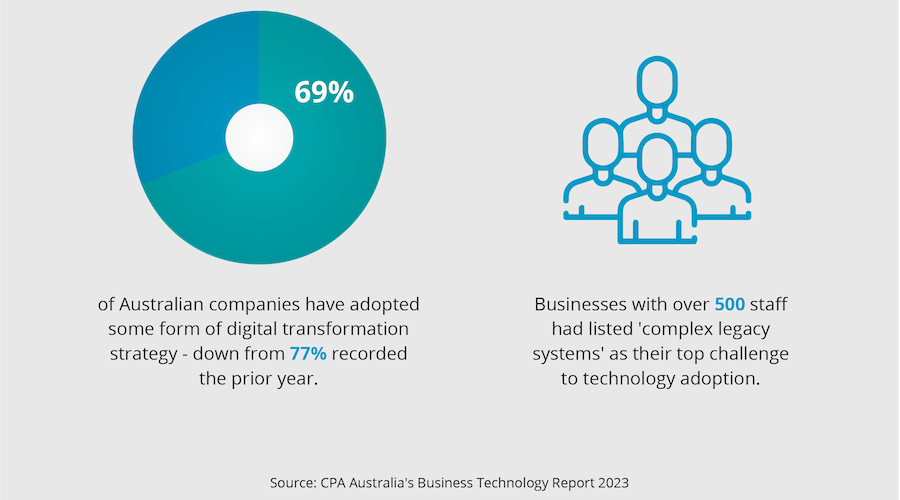Human Resource Information Systems (HRIS) have long been a frontrunner for managing and integrating people management functions. However, they are not without their limits and complications. Traditional, legacy systems often stand in the way of efficiency. While implementing a modern system can solve those problems, the process of HRIS transformation comes with its own challenges and needs to be managed well.
According to CPA Australia’s Business Technology Report 2023, 69% of Australian companies have some degree of digital transformation strategy. Yet, businesses with over 500 staff listed their top challenge to technology adoption as ‘complex legacy systems’. HRIS transformation is a comprehensive process, particularly for HR, Payroll and People & Culture functions in companies with large, shift-based workforces. However, these transformation projects come with the promise to streamline operations and improve efficiency business-wide. Understanding and addressing the challenges of an HRIS transformation can prevent it from falling under the wheels of your growing business.

Resistance to change management
Resistance to change is one of the primary hurdles in an HRIS transformation. For example, employees who are more accustomed to existing systems may be reluctant to adopt new technologies and processes. This resistance can stem from fear of the unknown, concerns about job security, or simply a comfort with the status quo. This is where change management strategies become an essential tool for managing expectations and engaging with employees early in the transformation process. Communicating the benefits of a new HRIS transformation project can help gain employee buy-in and reduce resistance. Training programs also encourage people to engage with the new system and ensure they have the knowledge to use it confidently and thus accelerate the return on investment.
Managing the HRIS transformation
The Australian Government’s Data Strategy 2021-2024 cited that over 50% of digital transformation projects fail to meet the demand of growing small to medium-sized businesses. An HRIS transformation project requires meticulous planning and strong leadership; not all businesses are set up to cater to this. When moving from any legacy system, your business should adopt a transformation roadmap across all affected departments. Maintaining regular meetings, clear timelines, and defined responsibilities can help the project stay on track. Keeping communication paths open and ensuring regular updates is critical for success.

Data integration and data quality
Data integration and quality are critical to the success of an HRIS transformation. Integrating data from disparate sources and systems and ensuring its accuracy can be a task fraught with human error. Poor data quality can lead to incorrect analytics, flawed business decisions, and operational inefficiencies. This is why your business must conduct a thorough data audit before undertaking any digital transformation. Cleansing the data and establishing ongoing data governance practices helps maintain integrity throughout the process.

Cost management
HRIS and associated ERP systems transformation can take a real bite out of your bottom line, and managing any associated costs is a significant challenge. The costs involved in HRIS transformation projects can include software licenses, implementation fees, training expenses, project management, change management, infrastructure and technology and (less likely in the modern age) potential downtime during the transition. To manage costs effectively, you must develop an extensive budget accounting for all potential expenses and include a reasonable contingency for unexpected costs. Projects of this scale often grow in scope as time progresses – clear objectives and deliverables are a must and are examined further below.

Technical challenges to ERP transformation
Technical challenges are inherent in any HRIS transformation, ranging from technical glitches during implementation to compatibility issues with your existing systems. According to research from Gartner, ERP implementation has a failure rate of 55-75%. Conducting pilot tests, creating a detailed technical plan, and involving both subject matter and IT experts in the process can help you identify and address any potential technical issues before they escalate.

No clear objectives
A common pitfall many businesses experience during an HRIS transformation is a lack of clear objectives. With well-defined goals, measuring the transformation’s success is made that much easier, as is making the necessary adjustments to any shortfall. Establish clear objectives immediately, focusing on your business’s short-term and long-term goals. Your objectives should meet the SMART goal threshold. In other words, they should be Specific, Measurable, Achievable, Realistic, and Time-bound. Review the transformation progress regularly to ensure that the HRIS transformation project meets its intended outcomes and remains flexible to pivot and adjust strategies as needed.

Conclusion
An HRIS transformation is a multifaceted process that requires some real consideration, careful planning, and execution. Before undergoing a transformation, you need to understand and prepare for potential challenges. Comprehensive planning, clear communication, and strong leadership are key to overcoming these challenges and increasing your probability of success. As the system evolves around growing business demand, you should manage any issues during deployment.
Let Tambla manage your HRIS transformation
At Tambla, we excel in transforming HR operations for large organisations with modern HRIS systems. Our comprehensive solutions and local service delivery enhance every project with a personal touch. The projects we complete enable companies to drive operational efficiency, elevate employee experiences, and empower your business to make informed decisions quickly.
Addressing the key challenges in an HRIS transformation project can ensure a smoother transition and maximise the benefits of your new HCM software or system. Visit our website to learn how our Consulting Services can support your HRIS transformation.
Related blogs
Navigating the transformation from legacy to modern ERP systems
What features should you look for in enterprise HR solutions?
4 areas where workforce analytics improves decision-making





